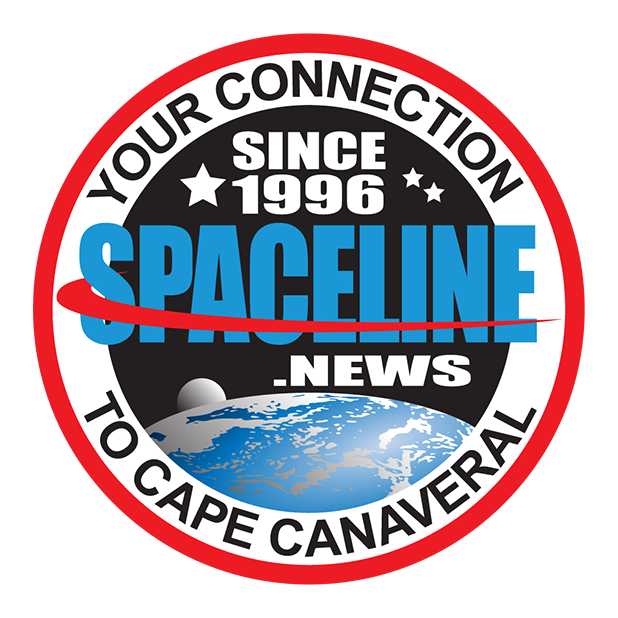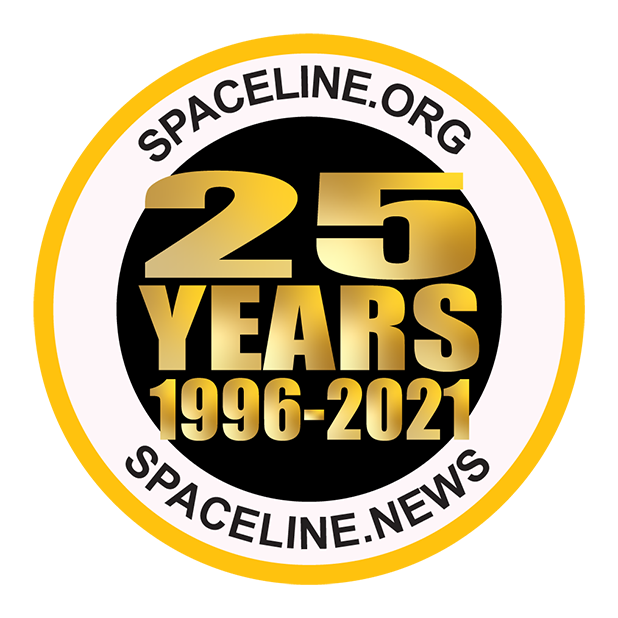
Falcon 9 Starlink V1.0-L22 Launch, Photo Courtesy Carleton Bailie/Spaceline
Falcon 9 Launches Another 60 Starlink Satellites
March 24, 2021 | Reported by Cliff Lethbridge
A SpaceX Falcon 9 rocket successfully launched 60 Starlink broadband satellites at 4:28 a.m. EDT today from Launch Pad 40 on Cape Canaveral Space Force Station on a mission designated Starlink V1.0-L22, the 23rd dedicated launch of Starlink satellites. The first stage booster employed today was being flown for the sixth time, having previously supported the GPS III-SV03 mission, the Turksat-5A mission and three Starlink missions. The booster was successfully recovered today with a landing on the "Of Course I Still Love You" drone ship positioned on the Atlantic Ocean about 400 miles northeast of Cape Canaveral. The payload fairing halves flown today have also flown before, one having supported the Sentinel-6A mission and the other having supported a Starlink mission. The two halves were recovered in a "wet" recovery, being pulled from Atlantic Ocean waters rather than being "caught" by vessels with huge nets. The Starlink satellites were successfully deployed about an hour after launch, bringing the total number launched to date to 1,385 although not all of these are still in orbit. That leaves the SpaceX-owned Starlink space-based Internet service a couple of hundred satellites shy of being able to offer their service world-wide, a goal likely to be met later this year.

Falcon 9 Starlink V1.0-L22 Downrange, Photo Courtesy Carleton Bailie/Spaceline

Falcon 9 V1.0-L21 Streak Shot, Photo Courtesy Liz Allen/Spaceline
Falcon 9 Launches 60 Starlink Satellites
March 14, 2021 | Reported by Cliff Lethbridge
A SpaceX Falcon 9 rocket successfully launched 60 Starlink broadband satellites at 6:01 a.m. EDT today from Launch Pad 39A at the Kennedy Space Center. This was the third Falcon 9 launch from Cape Canaveral in just ten days. The first stage booster employed today was being flown for a record ninth time, having previously supported the Crew Dragon Demo-1 mission, the RADARSAT mission, the SXM-7 mission and five Starlink missions. The booster was successfully recovered today with a landing on the "Of Course I Still Love You" drone ship positioned on the Atlantic Ocean about 400 miles northeast of Cape Canaveral. The Starlink satellites were successfully deployed about an hour after launch. This mission, designated Starlink V1.0-L21, was the 22nd dedicated launch of Starlink satellites, bringing the total number launched to 1,325 although not all of them are still in orbit. At this launch pace, SpaceX may be able to offer its Starlink space-based Internet service to the world later this year.

Falcon 9 V1.0-L21 Downrange, Photo Courtesy SpaceX

Falcon 9 Starlink V1.0-L20 Launch, Photo Courtesy Carleton Bailie/Spaceline
Falcon 9 Launches More Starlink Satellites
March 11, 2021 | Reported by Cliff Lethbridge
A SpaceX Falcon 9 rocket successfully launched 60 Starlink broadband satellites at 3:13 a.m. EST today from Launch Pad 40 on Cape Canaveral Space Force Station. Launch was set for March 9, 2021 but was postponed to allow additional pre-launch checks. The first stage booster employed today was being flown for the sixth time, having previously supported the Crew Dragon Demo-2 mission, the Anasis-II mission, the CRS-21 mission, the Transporter-1 mission and one Starlink mission. The booster was successfully recovered today with a landing on the "Just Read the Instructions" drone ship positioned on the Atlantic Ocean about 400 miles northeast of Cape Canaveral. The payload fairing halves, also recovered by specialized vessels on the Atlantic Ocean, had both flown before. One half previously supported the Anasis-II and SXM-7 missions, while the other half previously supported the Sentinel-6A mission. This mission, designated Starlink V1.0-L20, was the 21st dedicated launch of Starlink satellites. The satellites were successfully deployed about an hour after launch, bringing to a total of 1,265 Starlink satellites launched to date, although not all of them are still in orbit. At the current launch pace, SpaceX may be able to offer its space-based Starlink Internet service to the world later this year.

Falcon 9 Starlink V1.0-L20 Downrange, Photo Courtesy Carleton Bailie/Spaceline

Falcon 9 Starlink V1.0-L17 Launch, Photo Courtesy Carleton Bailie/Spaceline
Falcon 9 Launches 60 Starlink Satellites; Terms Of Service Released
March 4, 2021 | Reported by Cliff Lethbridge
A SpaceX Falcon 9 rocket successfully launched 60 Starlink broadband satellites at 3:24 a.m. EST today from Launch Pad 39A at the Kennedy Space Center. The 45th Space Wing, which oversees launch operations at the Cape, has been in the process of revising their launch weather criteria to be more flexible in light of technological advances. They may have already done so as weather for this launch was atrocious, with rain in the launch pad area and a cloud ceiling of about 1,000 feet. Overall, the launch was delayed about a month to allow additional checkouts of the rocket and to determine what caused a first stage booster to malfunction and crash into the Atlantic Ocean during a landing attempt in the Starlink V1.0-L19 mission on February 15, 2021. SpaceX said the failure was caused by heat damage to the booster. Launch was delayed about four days due to bad weather in the booster recovery area and additional time needed to troubleshoot the cause of a pre-launch abort which occurred during a launch attempt on February 28, 2021.

Clouds Obscure Falcon 9 Starlink V1.0-L17 Launch, Photo Courtesy Carleton Bailie/Spaceline
The first stage booster launched today, on mission V1.0-L17, was being flown for the 8th time, having previously supported the Iridium-8 mission, the Telstar 18 VANTAGE mission and five Starlink missions. The booster was successfully recovered with a landing on the "Of Course I Still Love You" drone ship positioned on the Atlantic Ocean about 400 miles northeast of Cape Canaveral. The rocket's payload fairing halves, also recovered by specialized vessels on the Atlantic Ocean, have each flown before. One half supported three previous Starlink missions and the other half supported two previous Starlink missions. Today's launch brings to a total of 1,205 Starlink satellites launched to date. Starlink is a SpaceX-owned space-based Internet service provider intended to provide service to unserved or underserved areas around the world, or as an alternative to traditional Internet service providers. With major testing of the Starlink system well underway, SpaceX has released cost information for their offering. In response to an e-mail inquiry in the Melbourne, Florida area, SpaceX said that there might not be service in that area until more Starlink satellites are launched and that the service, when available, would be on a first-come, first-served basis. Cost of the service was quoted as follows: Hardware, $499; Service, $99 per month; Shipping, $50; Tax, $38 with a down payment of $99 due immediately. Prices may vary by region.

Clouds Obscure Falcon 9 Starlink V1.0-L17 Launch, Photo Courtesy Carleton Bailie/Spaceline










